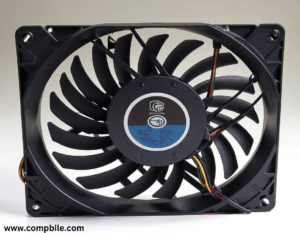- Cooling fans Case Fans (PC Fans): These are commonly used in computers to keep components like processors, graphics cards, and power supplies cool. They come in various sizes (typically 80mm to 140mm) and are mounted within the computer case.
- Heat Sink Fans: These fans are attached to heat sinks,
- often on CPUs, GPUs, or other heat-sensitive components.
- They help dissipate heat effectively.
- Axial Fans: These are the most common type of fans, where the air flows parallel to the fan’s axis.
- They are used in a wide variety of applications,
- from computer cases to air conditioning units.
- Centrifugal Fans: These fans blow air at a right angle to the intake.
- They are used in high-pressure applications such as
- in HVAC systems or industrial machines.
- Portable Fans: These are smaller, mobile fans used in homes or offices. They circulate air to provide personal cooling.
- Blower Fans: Similar to centrifugal fans, blowers are used for pushing air into a confined space
- or for specific applications like ventilation in electronics,
- servers, or vehicles.
Applications
- Electronics: Cooling fans are essential for preventing overheating of electronic devices such as computers, servers, and gaming consoles.
- Automotive: Cooling fans in cars are used to regulate engine temperature
- and the airflow over radiators
- and other engine components.
- HVAC Systems: Used to circulate air in heating, ventilation, and air conditioning systems, ensuring effective climate control.
- Industrial Machinery: Cooling fans in industrial settings help prevent machinery from overheating during heavy-duty operations.
- Home Comfort: Portable fans, ceiling fans, and air conditioning units often utilize cooling fans for improving air circulation and cooling rooms.
Fan Features
- Speed Control: Some cooling fans have variable speed settings, allowing users to control airflow based on needs.
- Noise Level: Higher-speed fans tend to produce more noise,
- which can be an important consideration for devices used in quiet environments.
- Energy Efficiency: Energy-efficient fans can reduce electricity consumption, a critical factor in large installations or continuous operation.
- Size: The size of the fan often determines its airflow capacity. For instance, larger fans can move more air, making them suitable for cooling larger areas or components.
Detailed Types of Cooling Fans
1.1. Computer Cooling Fans PC Fans
- Function: In computers, fans are used to cool the processor (CPU)
- , graphics processing unit (GPU),
- and power supply unit (PSU) to prevent thermal throttling,
- ensuring the system performs efficiently.
- Common Placement:
- CPU Fans: Typically integrated with the heat sink and placed directly on the CPU.
- GPU Fans: Attached to the graphics card to dissipate heat generated by the GPU.
- Case Fans: Installed on the side, top, or bottom of the computer case to create airflow that removes hot air and brings in cool air.
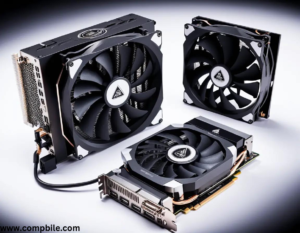
1.2. Ceiling Fans
- Function: Primarily used for cooling large rooms by circulating air to create a wind-chill effect on the skin, making the room feel cooler.
- Design Variations:
- Standard Ceiling Fans: Circulate air in a single direction.
- Reversible Ceiling Fans: Can reverse the direction of the blades, allowing the fan to circulate air downward in the summer and push warm air upward in the winter.
1.3. Tower Fans
- Function: These compact,
- vertical fans are used for space-saving cooling in homes or offices. They generally oscillate to provide even cooling.
- Special Features:
- Often come with additional features such as air purifiers, remote control, and multiple speed settings.
1.4. Pedestal and Floor Fans
- Function: Adjustable fans that sit on the floor and are typically more powerful than smaller desk fans.
- Use Case: Common in home or office spaces, these fans can cool larger areas effectively.
1.5. HVAC Fans Heating, Ventilation, and Air Conditioning
- Function: Used in commercial and residential air conditioning systems to distribute cooled or heated air throughout a space.
- Types:
- Exhaust Fans: Draw out hot air or moisture from a space (commonly used in kitchens and bathrooms).
- Blower Fans: Used to circulate air in HVAC systems.
1.6. Industrial Cooling Fans
- Function: Found in industries and factories,
- these are heavy-duty fans designed to keep machinery,
- workers, and equipment cool in high-heat environments.
- Common Types:
- Box Fans: Often used in warehouses or workshops.
- Large Blower Fans: Used for cooling in environments like server rooms or manufacturing facilities
2.1. Basic Fan Operation
- When the fan blades rotate, they push air across the surface of the object (or area) they are cooling, helping to transfer heat away.
- When the blades rotate, they lower the pressure in front of them, drawing cooler air in, while pushing the hotter air out.
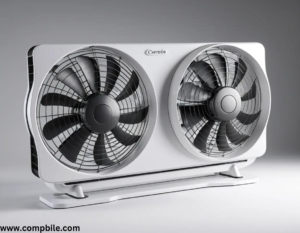
2.2. Heat Transfer Methods
- Fans generally rely on convection heat transfer,
- and the fan helps distribute that air.
- Here’s a breakdown of the key modes of heat transfer:
- Conduction: Heat transfer from one object to another (e.g., CPU to heat sink).
- Convection: Heat transfer from a hot surface to surrounding air (helped by the fan).
- Radiation: Transfer of heat through electromagnetic waves, usually irrelevant to fans but important in high-temperature scenarios.
3. Key Components of Cooling Fans
- Motor: The heart of the fan, usually powered by electricity.
- Brushless DC Motors: More energy-efficient and quieter, commonly used in high-performance applications (such as PC cooling fans).
- Blades: The part of the fan that interacts with the air to create airflow. Blades come in various shapes and materials (plastic, metal, etc.) to optimize airflow and noise reduction.
- Housing (Frame): The outer structure of the fan that holds the motor and blades in place.
- Fan Speed Control: Used to regulate the motor speed and airflow,
- which can be done manually or automatically
- (such as with temperature sensors in computer fans).
4. Advancements in Cooling Fan Technologies
4.1. Smart Cooling Fans
- Function: Modern cooling fans are now equipped with smart features such as:
- Temperature Sensors: Fans that automatically adjust their speed based on the temperature around them.
- Wi-Fi Connectivity: Enabling control via smartphone apps, allowing you to adjust the settings remotely.
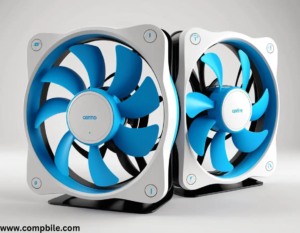
4.2. Liquid Cooling
In high-performance computing and gaming systems, liquid cooling has become an alternative to air cooling (fans).However, fans are still part of the system, assisting in cooling the liquid coolant.
4.3. Noise Reduction Technologies
- Bladeless Fans: Popularized by Dyson, bladeless fans use a unique design to provide smooth, strong airflow without the noise typically created by rotating blades.
- Acoustic Engineering: Improved motor and blade designs in computer fans have led to quieter operation, an essential factor for environments like home theaters or offices.
4.4. Energy Efficiency
- using more efficient motors and
- materials that require less power.
- Eco-friendly Designs: Some manufacturers are focusing on sustainable materials for fan construction, such as recycled plastics or energy-efficient motors.
4.5. Enhanced Airflow
- Blade Design: Advances in aerodynamics have led to more efficient blades that reduce drag and increase airflow while decreasing noise.
- Variable Speed Fans: Fans that can adjust their speed based on the heat load. This provides both energy efficiency and cooling effectiveness.
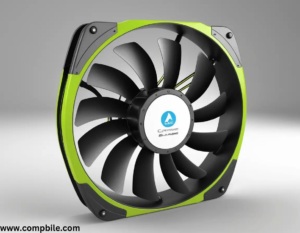
5. Challenges in Fan Design and Operation
- Heat Dissipation Efficiency: In systems with very high thermal output (like gaming PCs or servers), cooling fans might struggle to keep up, requiring additional methods such as liquid cooling or advanced airflow designs.
- Size and Placement: For large spaces or complex setups (e.g., server rooms or industrial cooling), proper fan placement and the correct fan size are critical to ensure even and effective cooling.
- Fan Maintenance: Over time, dust and dirt can accumulate in fans, causing them to run inefficiently or even fail. Regular maintenance (cleaning, lubrication) is necessary for optimal operation.
Get article on pdf file… click now
……Cooling fans……


